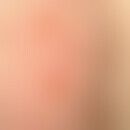Synonym(s)
DefinitionThis section has been translated automatically.
Candidosis of the nail plate without destruction of the keratin. Typical are grey-black or also greenish (in case of bacterial coinfection) discolorations of the lateral nail plate due to diffusion of microbial dyes.
EtiopathogenesisThis section has been translated automatically.
Yeast fungi do not possess their own keratinases; they cannot therefore attack an intact nail. Candida onychomycosis develops either in mixed infections of the paronychium (paronychia) or as a result of Candida paronychia. Yeast fungi are most frequently isolated from fingernails.
You might also be interested in
ClinicThis section has been translated automatically.
Chronic, usually moderately painful redness and swelling of the nail fold. The cuticle loses its adhesion to the nail plate so that foreign bodies can penetrate. Often it is completely missing. Bacterial superinfections occur frequently.
On pressure or spontaneously, thick white material consisting of horn components, pus and fungal elements can empty out of the nail pocket. With longer existence it can come to growth disturbances with thickening, discoloration, surface ripening, as well as to a softening and lysis (onycholysis) of the nail plate. In this constellation a candida onychomycosis is possible. Not infrequently the nail is greenish or grey-greenish discolored. This dyschromasia occurs when a bacterial superinfection with Pseudomonas aeruginosa or Klebsiellen is present.
TherapyThis section has been translated automatically.
LiteratureThis section has been translated automatically.
- Crawford F et al (2002) Oral treatments for toenail onychomycosis: a systematic review. Arch Dermatol 138: 811-816
- Ellis DH (1999) Diagnosis of onychomycosis made simple. J Am Acad Dermatol 40: S3-S8
- Gupta AK et al (2003) Non-dermatophyte onychomycosis. Dermatol Clin 21: 257-268
- Gupta AK et al (2000) Itraconazole pulse therapy for the treatment of Candida onychomycosis. J Eur Acad Dermatol Venereol 15: 112-115
- Hay RJ (1999) The management of superficial candidiasis. J Am Acad Dermatol 40: S35-S42
Disclaimer
Please ask your physician for a reliable diagnosis. This website is only meant as a reference.




